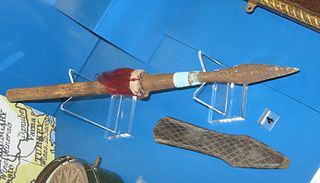

A war trophy is an item taken during warfare by an invading force. Common war trophies include flags, weapons, vehicles, and art.
Contents



A war trophy is an item taken during warfare by an invading force. Common war trophies include flags, weapons, vehicles, and art.

In ancient Greece and ancient Rome, military victories were commemorated with a display of captured arms and standards. A trophy (from the Greek tropaion) was originally a war memorial assembled from such items on a battlefield. The Roman triumph also displayed these items as well as cultural objects, which later came to be called war trophies. Body parts of slain enemies have sometimes served as trophies since antiquity, in a practice called human trophy collecting. The recovery of Roman eagles taken as trophies by enemy forces sometimes inspired years of added warfare.

In more recent times,[ ambiguous ] it has been common for soldiers to return home with souvenirs, such as enemy weapons and flags, while larger military items captured in battle, particularly weaponry such as machine guns and artillery pieces, became the property of the state to which the soldiers responsible for the capture belonged. [2]
In the 20th century, the victorious alliance states removed large quantities of property, including cultural objects. [3] After the First World War, the Treaty of Versailles authorized the removal of large amounts of property from Germany, which it termed "reparations". During the Pacific War, some American troops took the skulls and teeth of dead Japanese as war trophies, and during the occupation, as many as three million guntōs and swords were taken as trophies by the Americans. [4]
After the Second World War, the Potsdam Conference authorized the removal of certain property from Germany, such as the merchant marine fleet. Germany, during the war, had removed large quantities of property from the countries that it had occupied. In some cases, for example the Soviet "trophy brigades", official looting was euphemised as the taking of "trophies".
In the present day, the taking of war trophies continues, but weapons that are taken home as souvenirs are often deactivated first. According to Julian Thompson, only a small number of soldiers will take home war trophies, to avoid trouble – in a highly publicized case in 2012, British soldier Danny Nightingale was subject to a court-martial for illegally bringing a Glock with him after his tour in Iraq. [5]
Article 56 of the Hague Convention of 1907, [6] stated:
The property of municipalities, that of institutions dedicated to religion, charity and education, the arts and sciences, even when State property, shall be treated as private property.
All seizure of, destruction or wilful damage done to institutions of this character, historic monuments, works of art and science, is forbidden, and should be made the subject of legal proceedings.
However, the article was not much respected during the remainder of the century.
In 1954, a further convention was signed at the Hague: Convention for the Protection of Cultural Property in the Event of Armed Conflict , and two protocols have strengthened its force. [7]
Many works of art moved from their pre-war locations during the turmoils of the 20th century. UNESCO, the United Nations agency responsible for culture has been seeking to resolve issues relating to cultural objects displaced in connection with the Second World War. [8] However, the conference in Spring 2007 failed to reach a consensus on a draft non-binding declaration. [9]

Looting is the act of stealing, or the taking of goods by force, typically in the midst of a military, political, or other social crisis, such as war, natural disasters, or rioting. The proceeds of all these activities can be described as booty, loot, plunder, spoils, or pillage.
The Treaty on the Protection of Artistic and Scientific Institutions and Historic Monuments or Roerich Pact is an inter-American treaty. The most important idea of the Roerich Pact is the legal recognition that the defense of cultural objects is more important than the use or destruction of that culture for military purposes, and the protection of culture always has precedence over any military necessity.

The Hague Conventions of 1899 and 1907 are a series of international treaties and declarations negotiated at two international peace conferences at The Hague in the Netherlands. Along with the Geneva Conventions, the Hague Conventions were among the first formal statements of the laws of war and war crimes in the body of secular international law. A third conference was planned for 1914 and later rescheduled for 1915, but it did not take place because of the start of World War I.

Militaria, also known as military memorabilia, are military equipment which are collected for their historical significance. Such items include firearms, swords, sabres, knives, bayonets, helmets and other equipment such as uniforms, military orders and decorations and insignia.
International humanitarian law (IHL), also referred to as the laws of armed conflict, is the law that regulates the conduct of war. It is a branch of international law that seeks to limit the effects of armed conflict by protecting persons who are not participating in hostilities and by restricting and regulating the means and methods of warfare available to combatants.

The Hague Convention for the Protection of Cultural Property in the Event of Armed Conflict is the first international treaty that focuses exclusively on the protection of cultural property in armed conflict. It was signed at The Hague, Netherlands, on 14 May 1954 and entered into force on 7 August 1956. As of July 2021, it has been ratified by 133 states.

Nazi plunder was organized stealing of art and other items which occurred as a result of the organized looting of European countries during the time of the Nazi Party in Germany.

Cultural heritage is the heritage of tangible and intangible heritage assets of a group or society that is inherited from past generations. Not all heritages of past generations are "heritage"; rather, heritage is a product of selection by society.

Repatriation is the return of the cultural property, often referring to ancient or looted art, to their country of origin or former owners.

A prize of war is a piece of enemy property or land seized by a belligerent party during or after a war or battle, typically at sea. This term was used nearly exclusively in terms of captured ships during the 18th and 19th centuries.

The Blue Shield, formerly the International Committee of the Blue Shield, is an international organization founded in 1996 to protect the world's cultural heritage from threats such as armed conflict and natural disasters. Originally intended as the "cultural equivalent of the Red Cross", its name derives from the blue shield symbol designed by Jan Zachwatowicz, used to signify cultural sites protected by the 1954 Hague Convention for the Protection of Cultural Property in Armed Conflict.

Looted art has been a consequence of looting during war, natural disaster and riot for centuries. Looting of art, archaeology and other cultural property may be an opportunistic criminal act or may be a more organized case of unlawful or unethical pillage by the victor of a conflict. The term "looted art" reflects bias, and whether particular art has been taken legally or illegally is often the subject of conflicting laws and subjective interpretations of governments and people; use of the term "looted art" in reference to a particular art object implies that the art was taken illegally.
The Convention on the Protection of the Underwater Cultural Heritage is a treaty that was adopted on 2 November 2001 by the General Conference of the United Nations Educational, Scientific and Cultural Organization (UNESCO). The convention is intended to protect "all traces of human existence having a cultural, historical or archaeological character" which have been under water for over 100 years. This extends to the protection of shipwrecks, sunken cities, prehistoric art work, treasures that may be looted, sacrificial and burial sites, and old ports that cover the oceans' floors. The preservation of underwater cultural heritage is significant as it allows for the retelling of numerous historical events. As part of its duty to conduct scientific research and provide continuous education on the importance of underwater cultural heritage, UNESCO strives to maintain these sites for the enjoyment of current and future generations. The convention may provide a customary framework to help raise awareness and seek to combat the illegal looting and pirating occurring in waters worldwide. As an international body, member states of the convention agree to work towards the preservation of sunken cultural property within their jurisdiction and the high seas.
The antiquities trade is the exchange of antiquities and archaeological artifacts from around the world. This trade may be illicit or completely legal. The legal antiquities trade abides by national regulations, allowing for extraction of artifacts for scientific study whilst maintaining archaeological and anthropological context. The illicit antiquities trade involves non-scientific extraction that ignores the archaeological and anthropological context from the artifacts.

Cultural property, also known as cultural patrimony, comprises the physical items that are part of the cultural heritage of a group or society, as opposed to less tangible cultural expressions. They include such items as cultural landscapes, historic buildings, works of art, archaeological sites, as well as collections of libraries, archives, and museums.

The Swiss Agency for the Protection of Cultural Property defines measures to protect cultural property against damage, destruction, theft and loss. For this purpose, a legal basis has been established at the national level and international agreements have been made that oblige Switzerland to respect and support the protection of cultural property not only on its own territory but also on the sovereign territory of other state parties.

The UNESCO 1970 Convention on the Means of Prohibiting and Preventing the Illicit Import, Export and Transfer of Ownership of Cultural Property is an international treaty to combat the illegal trade in cultural items. It was signed on 14 November 1970 and came into effect on 24 April 1972. As of October 2022, 142 states have ratified the treaty.

"The Spoils of War—World War II and Its Aftermath: The Loss, Reappearance, and Recovery of Cultural Property" was an international symposium held in New York City in 1995 to discuss the artworks, cultural property, and historic sites damaged, lost, and plundered as a result of World War II. The three-day event was sponsored by the Bard Graduate Center for Studies in the Decorative Arts to commemorate the 50th anniversary of the end of the war. The conference was organized by Elizabeth Simpson, an archaeologist and professor at the Bard Graduate Center.

Russia began an invasion of Ukraine on 24 February 2022, in a major escalation of the Russo-Ukrainian War that began in 2014. It is the largest military attack in Europe since World War II. During the fighting, many pieces of Ukrainian cultural heritage were either destroyed, damaged, or put at risk due to the widespread destruction across the country. This deliberate destruction and looting of over 500 Ukrainian cultural heritage sites is considered a war crime and has been described by Ukraine's Minister of Culture as cultural genocide.